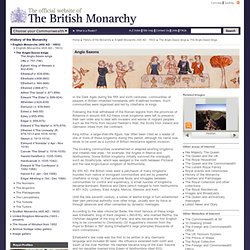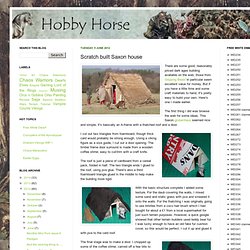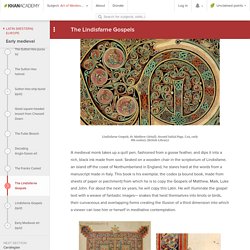

Primary History - Anglo-Saxons - Who were they? Primary History - Anglo-Saxons. Feasting with Early Medieval Chiefs: Locating Political Action through Environmental Archaeology. Hrisbru excavation site Feasting with Early Medieval Chiefs: Locating Political Action through Environmental Archaeology Session: Early Medieval Europe I Davide M.

Zori (Center for Medieval and Renaissance Studies, Univ. of California–Los Angeles) This excellent paper was the first given in the session on Early Medieval Europe. The Anglo-Saxon kings. In the Dark Ages during the fifth and sixth centuries, communities of peoples in Britain inhabited homelands with ill-defined borders.

Such communities were organised and led by chieftains or kings. Following the final withdrawal of the Roman legions from the provinces of Britannia in around 408 AD these small kingdoms were left to preserve their own order and to deal with invaders and waves of migrant peoples such as the Picts from beyond Hadrian's Wall, the Scots from Ireland and Germanic tribes from the continent. King Arthur, a larger-than-life figure, has often been cited as a leader of one or more of these kingdoms during this period, although his name now tends to be used as a symbol of British resistance against invasion.
The invading communities overwhelmed or adapted existing kingdoms and created new ones - for example, the Angles in Mercia and Northumbria. Ethelberht's law code was the first to be written in any Germanic language and included 90 laws. Featured English Monarch. Anglo Saxon Chronicle. Welcome to Britannia's online version of the Anglo-Saxon Chronicle, one of the most important documents that has come down to us from the middle ages.

It was originally compiled on the orders of King Alfred the Great in approximately A.D. 890, and subsequently maintained and added to by generations of anonymous scribes until the middle of the 12th Century. The original language was Anglo-Saxon (Old English), but later entries were probably made in an early form of Middle English. We like to think of this document as the ultimate timeline of British history from its beginnings up to the end of the reign of King Stephen in 1154. The Chronicle certainly does not present us with a complete history of those times and is probably not 100% accurate, either, but that doesn't diminish its enormous value in helping us to arrive at a clearer picture of what actually happened in Britain over a thousand years ago. The Translation This translation is by Rev. Learning Zone Class Clips - What was the Anglo Saxon Chronicle? - History Video. The Anglo-Saxon Chronicle: Part 1: A.D. 1 - 748. File:Anglo-Saxon Chronicle - C - 871.jpg.
Life in Saxon and Viking times: NEN Gallery. Anglo-Saxon and Viking Houses and Furniture. The Saxons generally built their houses of wood although, after they had accepted Christianity, some of their churches were built in stone.

Of course, at the time, people had been building in wood for thousands of years, so they would have known far more about making wooden buildings than we do today and they had far more timber to choose from. The problem with wooden buildings is that they catch fire and decay much more easily than stone buildings, which meant that they had to be replaced more often. Indeed, there is some evidence to suggest that, at least amongst the nobility, it was considered 'not the done thing' to live in an old building, so some perfectly serviceable buildings would have been replaced for no more reason than personal vanity. The Vikings also had a long tradition of building in wood, and many of the early medieval wooden churches from Scandinavia survive to this day.
Types of Buildings Sunken Featured Buildings. Framed Buildings. Hobby Horse: Scratch built Saxon house. There are some good, reasonably priced dark ages building available on the web, those from Gripping Beast in particular seem excellent value for money.

But if you have a little time and some craft materials to hand, it's pretty easy to build your own. Here's one I made earlier. The first thing I did was browse the web for some ideas. This Saxon grubenhaus seemed nice and simple, it's basically an A-frame with a thatched roof and a door. I cut out two triangles from foamboard, though thick card would probably be strong enough. The Lindisfarne Gospels. Lindisfarne Gospels, St.

Matthew (detail), Second Initial Page, f.29, early 8th century (British Library) A medieval monk takes up a quill pen, fashioned from a goose feather, and dips it into a rich, black ink made from soot. Seated on a wooden chair in the scriptorium of Lindisfarne, an island off the coast of Northumberland in England, he stares hard at the words from a manuscript made in Italy. This book is his exemplar, the codex (a bound book, made from sheets of paper or parchment) from which he is to copy the Gospels of Matthew, Mark, Luke and John. For about the next six years, he will copy this Latin. Lindisfarne Gospels, John cross-carpet page f 210v (British Library) The book is a spectacular example of Insular or Hiberno-Saxon art—works produced in the British Isles between 500-900 C.E., a time of devastating invasions and political upheavals. Anglo-Saxon. Beowulf Text, Summaries, & Translations.